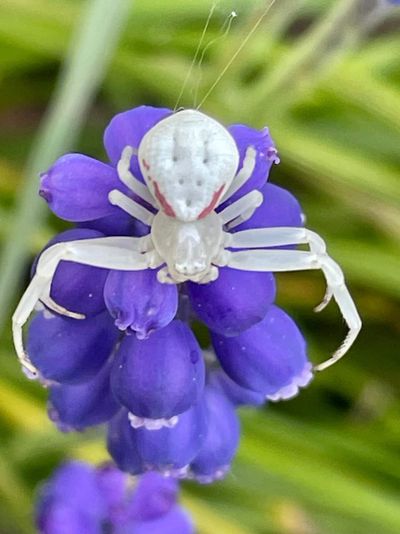Bugging the Northwest: Meet the color-changing spider whose meals – and fate – depend on the flower where it sits

Talk about trickery.
A spider that resembles a crab also changes color to blend in with the flower it sits on. Perched atop a buttercup, it turns yellow. On a daisy? White, of course.
Meet Misumena vatia, a flower-dwelling spider with crablike legs and movements that resides in Washington state. Commonly called the flower crab spider, it has the unique ability to switch colors between white, yellow and pale green, according to Rod Crawford, spider expert at the University of Washington Burke Museum in Seattle.
“This species has the predatory strategy of hanging out on flowers and preying on visiting pollinators,” he said.
Instead of building webs to snare prey, they grab it with their two strong front legs. “A bite from M. vatia can quickly kill prey many times its own size,” Crawford explained, emphasizing that its venom is not dangerous to humans.
Unlike chameleons that can change color in as little as 20 seconds, flower crab spiders are not quick-change artists. Instead, the transformation takes anywhere from two to 20 days. The spiders are able to turn white considerably quicker than to yellow or green, according to a 2005 study in the Journal of Experimental zoology.
But flowers come in all kinds of colors – there’s purple lupine, red roses and blue hyacinth, to name a few. What happens if M. vatia perches on one to await its next meal?
Chances are “it’s out of luck,” Crawford said.
The photograph taken by Amy Quattlebaum of a white flower crab spider perched on a purple flower top in Vancouver illustrates why. Notice how the critter would stand out to bees and moths flitting about nearby. Also, as the highly visible spider waits patiently for prey that doesn’t come, it can become prey itself to a hungry wasp or bird.
All of which means that M. vatia’s dining success – and its survival – depends largely on the color of the real estate it rents.
Of the 72 crab spider species known to live in Washington state, “most of the others are relatively dull-colored,” Crawford said. What they share, however, is their crablike appearance. Their legs are rotated at the base, giving them the ability to scuttle sideways. Also, their two front legs, longer than the others, typically extend from each side of the body. And they use those two large legs to reach out and grab prey. Then the spider injects paralyzing venom to immobilize it. Dinnertime.
For those of you who find this off-putting, please keep in mind that M. vatia isn’t evil. Just like us, it’s drawn to pretty flowers and a good meal.